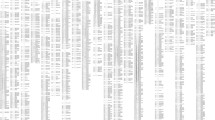Abstract.
A genetic linkage map of mungbean (Vigna radiata, 2n = 2x = 22) consisting of 255 RFLP loci was developed using a recombinant inbred population of 80 individuals. The population was derived from an inter-subspecific cross between the cultivated mungbean variety 'Berken' and a wild mungbean genotype 'ACC 41' (V. radiata subsp. sublobata). The total length of the map, which comprised 13 linkage groups, spanned 737.9 cM with an average distance between markers of 3.0 cM and a maximum distance between linked markers of 15.4 cM. The mungbean map was compared to a previously published map of lablab (Lablab purpureus, 2n = 2x = 24) using a common set of 65 RFLP probes. In contrast to some other comparative mapping studies among members of the Fabaceae, where a high level of chromosomal rearrangement has been observed, marker order between mungbean and lablab was found to be highly conserved. However, the two genomes have apparently accumulated a large number of duplications/deletions after they diverged.
Similar content being viewed by others
Author information
Authors and Affiliations
Additional information
Electronic Publication
Rights and permissions
About this article
Cite this article
Humphry, .M., Konduri, .V., Lambrides, .C. et al. Development of a mungbean (Vigna radiata) RFLP linkage map and its comparison with lablab (Lablab purpureus) reveals a high level of colinearity between the two genomes. Theor Appl Genet 105, 160–166 (2002). https://doi.org/10.1007/s00122-002-0909-1
Received:
Accepted:
Issue Date:
DOI: https://doi.org/10.1007/s00122-002-0909-1




